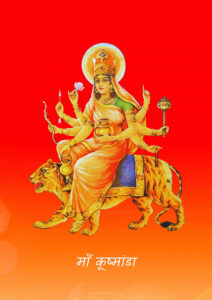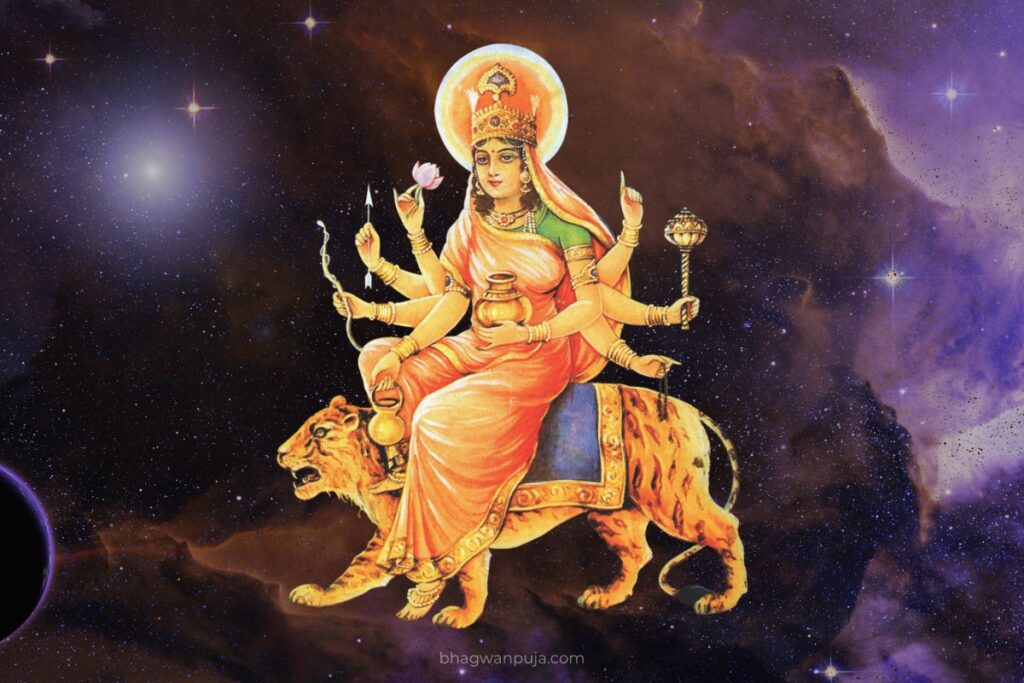Navratri, a nine-day festival, celebrates the nine divine forms of Goddess Durga. This year, Navratri commences on Sunday, October 15, and concludes on Tuesday, October 24. In Hindu religious beliefs, the concept of Navdurga originates from Goddess Parvati, who wields supreme power among all the goddesses. On the fourth day of Navratri, we pay homage to Goddess Kushmanda, whose name symbolizes ‘Ku’ (a little), ‘Ushma’ (warmth or energy), and ‘Anda’ (cosmic egg). Goddess Kushmanda is revered as the deity of light energy and is believed to bestow health, wealth, and strength. Due to her possession of eight hands, she is also known as Asthabhuja Devi.
History of the Worship of Goddess Kushmanda
The tale of Goddess Kushmanda’s worship unfolds at a time when there was nothing but emptiness in the universe. Darkness shrouded everything, with no signs of life. Then, a ray of divine light suddenly appeared, slowly illuminating the void. Initially formless, the rays of light eventually took on a clear shape, that of a divine lady. This first being of the universe was Maa Kushmanda. Her arrival signified her ability to create the universe with her gentle smile, replacing darkness with light and breathing life into the cosmos.
 She is also referred to as “Sakti” because she created the Sun, planets, stars, and galaxies. Seating herself in the center of the Sun, she became the source of all energy in our universe, giving life to all living beings through the sun’s rays.
She is also referred to as “Sakti” because she created the Sun, planets, stars, and galaxies. Seating herself in the center of the Sun, she became the source of all energy in our universe, giving life to all living beings through the sun’s rays.
Following this, Maa Kushmanda brought three divine goddesses into existence. Using the central eye on her forehead, she created ‘Mahalaxmi,’ her left eye formed ‘Mahakaali,’ and her third eye gave birth to ‘Maa Sarasvati.’ Mahakali’s body brought forth a male and female; the male was named Shiva, and the female was Maa Saraswati. Similarly, Mahalaxmi gave birth to a male, Brahma, and a female, Lakshmi.
Maa Kushmanda gazed at Mahasaraswati, who also gave birth to a male and female. The male was named Vishnu, and the female was Sakti. Following this, Maa Kushmanda offered Maa Saraswati to Brahma, Lakshmi to Vishnu, and Sakti to Shiva.
Maa Kushmanda then absorbed all three divine goddesses within herself, embodying Shakti in the form of an object of divine, powerful, and unending energy.
Maa Kushmanda Puja Date & Timing:
Maa Kushmanda Puja will take place on October 6, 2024, as part of the Navratri celebrations. The day is dedicated to worshiping Maa Kushmanda, who is believed to bring vitality and positive energy. Devotees often observe rituals and wear the color orange, symbolizing warmth, joy, and energy.
Puja Vidhi and Rituals:
To worship Goddess Kushmanda on the fourth day of Navratri, wear yellow clothing, and offer yellow sandalwood, kumkum, marigold flowers, and akshat during the puja. While reciting the mantra “Om Brihaspate Namah,” offer saffron on a betel leaf and chant one rosary of “Om Kushmandayai Namah.” Reciting the Durga Saptashati or Siddha Kunjika Stotra is especially beneficial for unmarried girls, believed to help them find a suitable groom. Perform the puja with a pure and sincere heart to seek the blessings of Maa Kushmanda for success, prosperity, and good health.
Significance of Worshiping Maa Kushmanda on the Fourth Day of Navratri:
Maa Kushmanda is the Goddess of light energy and the giver of a healthy life. The word “Kushmanda” in Sanskrit means ‘Ku’ (little), ‘Ashma’ (energy or light), and ‘Anda’ (egg). It is believed that when Lord Vishnu began creating the universe, darkness enveloped everything. Then, a formless light, akin to a goddess, spread across the cosmos when she smiled, illuminating the entire universe, planets, and all. It is also believed that she became the primary source of light, providing energy, light, and heat even to the sun.
Conclusion:
On the fourth day of Navratri, we worship Goddess Kushmanda, who presides over the Anahata Chakra. For those struggling with depression, fear, anxiety, and nervousness, devout worship of Goddess Kushmanda can bring positive energy and bestow a healthy life.
